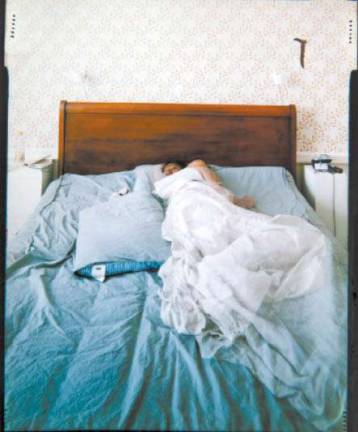Twelfth Night

Photographer seeks one last night with long-lost love
One of photographer Florence Montmare's most important relationships ended in 2002, when she broke up with a man she shared an apartment with, a man she thought she'd be with forever.
Now, more than a decade later, she's inviting him to share a bed with her, one last time.
For Illuminations, her mixed-media exhibition at Ivy Brown Gallery in the Meatpacking District, which centers on photographs taken of the couple sleeping in bed as their relationship slowly deteriorated, Montmare handwrote a letter to her former partner, asking that he join her in bed for a final portrait. On Oct. 12, she will wait for him in a double bed from noon until midnight.
"I feel like we should meet each other, one more time," she said. "It's intuitive."
Twelve years ago, Montmare and her boyfriend, a fellow photographer, traveled around France and Sweden, eventually renting a large apartment in Stockholm, where they realized separation was inevitable.
During the last months of the relationship, Montmare, plagued with severe insomnia, set up a large-format camera at the foot of their bed and shot extended exposure photographs each night, leaving the shutter open for up to eight hours at a time.
"It was hard for me to stay in bed, so for me to be able to do that, I had to work," Montmare said. "It was almost like putting a straightjacket on myself."
The ghostly images make up the crux of her show, which she's been working on since first sharing the photographs with gallery owner Ivy Brown more than two years ago.
"It's a very unique person that's going to want to do something like this," said Brown. "A lot of people just want to show their work and that's it. And they're not interested in creating these other levels and other dimensions to it. It's very, very unique. It's not something that I come across very often."
The Vienna-born artist grew up in Stockholm and has lived in New York for around 18 years, residing nearly all that time on the Upper West Side. She's petite, with a thin, elegant frame, auburn hair and blunt, short bangs. About seven years ago, she married another man, a clown with Cirque de Soleil, with whom she spends much of the summer on a houseboat in the Rockaways, along with their Italian greyhound, Pony.
Illuminations captures Montmare in bed, struggling to sleep while covered in white and floral sheets that, due to the lengthy exposure, offer an ethereal veil. In some photographs a faint outline of the husky, bald-headed figure of her boyfriend appears like a whisper. In other images, he's central, no more so than in the first shot of the series, which finds him sitting at the edge of the bed, naked from the waist up and staring out the bedroom window.
Unlike the delicate wisps of the bodies in the bed, the inanimate objects in the photographs are fully realized. A package of earplugs, an eye mask, black diaries, rolls of toilet paper, and a bag of Swedish candy lay on nightstands and on the floors, all evidence of the artist's nocturnal restlessness.
"Our bodies are the only things that aren't trenchant," Montmare said. "They're more fleeting."
Brown said that exploring past trauma is something we're often discouraged to do, and it's partially what excites her about the show.
"You just want to leave it behind and walk away and move forward," Brown said. "Everybody tells you to move forward and not look back."
As she installs the work in the gallery, where a double bed sits kitty-cornered in a dark wood bedframe and covered with a patchwork quilt, acting as a temporary play space for Pony and Brown's dogs, Buster and Keaton, Montmare feels nervous about the potential reunion and the possibility of a no-show. Her insomnia has returned, the result of reading her diaries from the summer of 2002 and listening to recordings of the relationship's final conversations. She's adding some of the objects from the photographs to the exhibit, and the diaries will provide text, creating a multi-sensory experience of the relationship and its demise.
"It's artifacts of a relationship," she said. "These objects are witnesses to our existence.